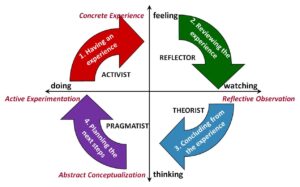What is Self-Consciousness?

Self-Consciousness is a heightened sense of Self-Awareness.
It is a preoccupation with oneself, as opposed to Self-Awareness, which is the awareness that one exists as an individual.
Self-consciousness is being excessively aware of one’s appearance or manner.
However, the two terms are commonly used interchangeably or synonymously.
Some people are habitually more Self-Conscious than others. Self-consciousness is sometimes associated with shyness or paranoia or may occur when one feels one is being watched.
Self-consciousness is often associated with shyness and embarrassment, resulting in a lack of pride and low self-esteem.
On the positive side, Self-Consciousness may help in identity development. This is because some people come the closest to knowing themselves objectively during periods of high Self-Consciousness.
Self-consciousness affects people to varying degrees. Some are constantly Self-Monitoring or Self-Involved, while others are completely oblivious to themselves.
Private/Public Self-Consciousness
Private Self-Consciousness is a tendency to introspect and examine one’s inner self and feelings.
Public Self-Consciousness is an awareness of the self as others view it.
Private and Public Self-Consciousness constructs are distinguished based on the direction of the focus of one’s attention.
Inward feelings and beliefs one has toward oneself, or outward thoughts about what others might think about them.
This kind of Self-Consciousness can result in Self-Monitoring and social anxiety.
Both Private and Public Self-Consciousness are viewed as Personality Traits, meaning they are relatively stable over time but not correlated.
Just because an individual is high on one dimension doesn’t mean they are high on the other.
Self-consciousness can strongly influence behavior.
Public and Private Self-Consciousness have been traditionally investigated and measured since the 1970s when Fenigstein developed the Self-Consciousness Scale (SCS).
Adaptive/Maladaptive Self-Consciousness
The adaptive and maladaptive aspects of Self-Consciousness emerged as a research topic mainly in the 1990s.
Attention toward oneself could be associated with psychological mindedness and well-being, psychological distress, and negative mood states.
Researchers distinguished between being aware of one’s thoughts and beliefs (the Adaptive side of being self-aware) and being unable to advance critical thinking (its maladaptive side of Self-Focus).
According to Ingram (1990), psychological distress occurs when Self-Attention is inflexible. Thus, Self-Absorption is the product of disproportional, inappropriate, and excessive focus on Self-Attention.
McKenzie and Hoyle (2008) created the Self-Absorption Scale (SAS), which measures Self-Absorption’s private and public facets.
To other researchers, maladaptive Self-Attention occurs in the context of Self-Regulation processes when discrepancies between one’s Self-Evaluative contents produce adverse effects and negative psychopathological states.
Such adverse effects are associated with depression and anxiety, generating a neurotic Self-Attentiveness.
Trapnell and Campbell (1999) called this neurotic self-attention self-rumination, which was the basis of their Reflection–Rumination Questionnaire (RRQ).
Rumination was defined as thoughts that frequently recur and are usually unwelcome.
Rumination is related to psychopathological traits such as neuroticism, whereas Self-Absorption appeared to be a more generic characteristic.
Yet, Rumination has also been associated with artistic creativity, mainly among musicians.
Past/Present Self-Consciousness
The past/present aspects of Self-Consciousness refer to the temporal instance that qualifies the Self-Conscious experience.
On the one hand, Self-Consciousness is viewed as a reflexive experience and, thus, as a synonym for Self-Reflection.
Some researchers (Anderson, 1996; Creed and Funder, 1998; Silvia, 1999) consider Self-Reflection a dimension of private Self-Consciousness. In this context, it is related to inspecting and evaluating one’s thoughts, feelings, and behaviors.
This is consistent with James’ (1890) idea of thought and the distinction between “I” and “Me.”
As such, reflecting or thinking about the self requires the subject to become the object of their thoughts. Thus, a reflection must refer to some content located in experience.
On the other hand, Self-Consciousness can be associated with a present moment of Self-Experience, in which one is aware of one’s experience without any reflexive judgment attached, which is usually investigated in mindfulness studies.
Theory and research on Self-Consciousness focused on Eastern traditions, specifically mindfulness, have been growing interest in psychological literature.
Mindfulness is considered different from other conscious states, such as Self-Concept, schemes, and other constructs related to Self-Reflection. It is solely related to the quality of the conscious experience at the moment of its occurrence. Therefore, it should not be associated with reflexive content.
Mindfulness has two main components: Sustained Attention to the present moment (Awareness) and an open attitude toward the experience (Acceptance).
This way, consciousness in the present moment is understood as continuously monitoring internal and external events.
Hence, there are two approaches to Self-Consciousness regarding its focus.
The ‘past’ approach relates to a reflective instance and presupposes the content to which Self-Focus is addressed.
And the ‘present’ approach entails a non-themed consciousness of one’s present experience as a whole.
These two features of Self-Consciousness suggest two distinguishable epistemological focuses.
One is focused on the content and information carried out by thoughts and procedural memory cognition. While the other is focused on phenomenal, embodied, and situated cognition.



